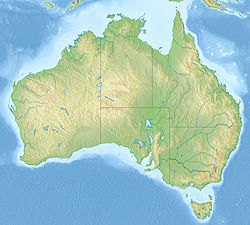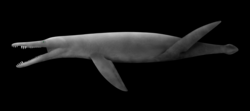Top Qs
Timeline
Chat
Perspective
Toolebuc Formation
Geological formation in Australia From Wikipedia, the free encyclopedia
Remove ads
The Toolebuc Formation is a geological formation that extends from Queensland across South Australia and the Northern Territory in Australia, whose strata date back to the Albian stage of the Early Cretaceous. Dinosaurs,[1] pterosaurs, plesiosaurs, ichthyosaurs, protostegid turtles, sharks, chimaeroids and bony fish remains are among the fossils that have been recovered from the formation.
Remove ads
Description
Deposition occurred in a cool to temperate inland sea setting and the present lithology is dominantly made up of limey shales with abundant Inoceramus bivalve shells. Ichthyosaurs and protostegid turtles were the most common marine reptiles at this time in the Eromanga Sea, in contrast to older Aptian deposits such as the Bulldog Shale of South Australia, which show that plesiosaurs were previously more abundant and also more diverse. The Toolebuc Formation is one of the richest known sources of Mesozoic vertebrate fossils in Australia, with notable collecting areas situated around the towns of Richmond, Julia Creek, Hughenden and Boulia.
Remove ads
Fossil content
Summarize
Perspective
Possible indeterminate ankylosaurid remains are present in Queensland, Australia.[1] Indeterminate ornithopod remains have also been found in Queensland, Australia.[1]
Animals
Dinosaurs
Pterosaur
Plesiosaurs
Icthyosaurs
Turtles
Fish
Arthropod
Molluscs
Remove ads
See also
- List of dinosaur-bearing rock formations
- Paja Formation, Kronosaurus and Platypterygius Lagerstätte in Colombia
- Sierra Madre Formation, contemporaneous fossiliferous formation of Mexico
- Santana Group, contemporaneous Lagerstätte in northeastern Brazil
References
Wikiwand - on
Seamless Wikipedia browsing. On steroids.
Remove ads










